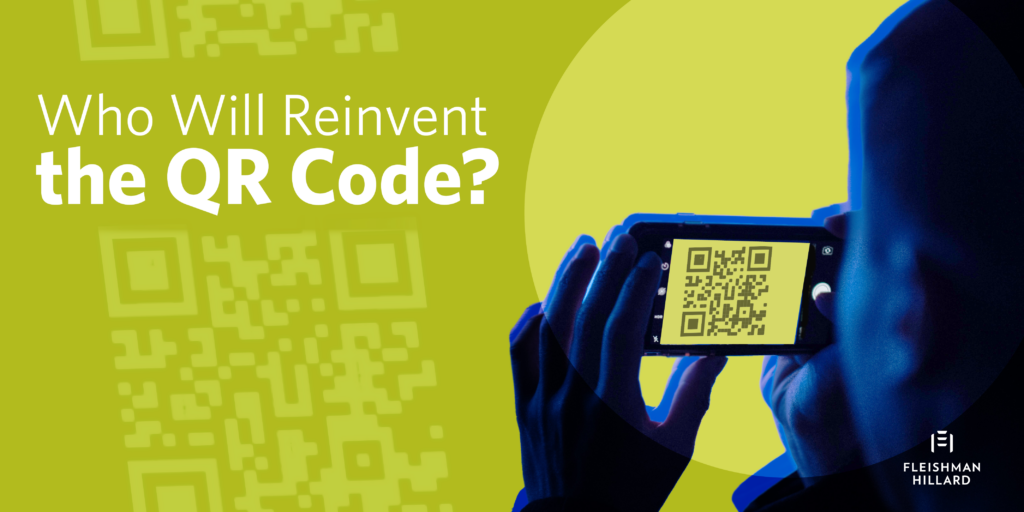Tick Tock Tech – Consumer and Technologists are Asking: Who Will Reinvent the QR Code?
Technological innovation can come from the pursuit of convenience or a need to solve a widespread problem that many of us are experiencing at once. This has resulted in innovation that is here to stay, from safe and swifter ways to pay to the ability to ensure we are almost never lost, thanks to the tiniest amount of cellular reception powering our favorite map apps. But occasionally, the key to solving one of society’s most common problems may be to look back and not forward – back to 1994 and the invention of the quick response (QR) code.
Current QR Code Uses and Concerns
You cannot go out in public in 2022 without seeing a QR code. The unmistakable mosaic tile that simultaneously appears both futuristic and retro can be found on storefront windows, giving users quick access to a website or hours of operation. It has virtually replaced physical menus in every restaurant, regardless of casual or formal settings. They’ve also been found as sidewalk chalk art or wild postings on scaffolds and construction sites.
It was not always like this. Despite the QR code’s introduction in the early 90s, you would be forgiven if you thought it was a recent innovation. The iPhone was not able to scan QR codes in its native camera app until just a few years ago, which has no doubt helped drive consumer adoption. In fact, one report noted there was 94% growth in use from 2018 to 2020 and two-thirds of survey respondents said the codes make life easier. So, success is on the QR code’s side. It is popular with businesses, does its job with almost no errors and consumers say they love them. Yet, when you zoom out there is ground to wonder: why hasn’t anyone reinvented the QR code?
One design flaw of the QR code is that for all its complexity, it fails to communicate where scanning it will take you. Instead, the information you will access by scanning is usually implied by the code’s physical placement or communicated with free-floating text somewhere around the code. Yet, we have collectively granted QR codes trust to take us somewhere safe in a way we do not for URLs, despite the fact the URLs include brand names and keywords to provide the recipient with more information. One brand’s recent Super Bowl QR code commercial was just as beloved by consumers as it was maligned by critics for asking viewers to scan a QR code without context. Viewers, it seems, were happy to. This is not an isolated brand event. A large tech company just recently flew drones into a QR code shape over a major city, inviting residents to scan the code in the sky, sparking similar amounts of praise and security criticism.
Building a Better QR Code
A QR code reinvented for today might want to solve the security context issue, incorporating text or standardized icons that communicate what the user will receive from the code itself. A look at today’s most popular apps reveals another opportunity. Implementations of QR codes implies one thing – it simply looks outdated in today’s aesthetically-driven tech world. Big brands have taken inspiration from the format but altered the grid with fun art, glowing lights and other iconography to make the codes look more like surprise-and-delight art and less like an ISCI barcode you scan at self-checkout.
Maybe we do not need a visual code at all. Perhaps the QR codes’ successor is already here in the form of Near Field Communication (NFC), which provides similar tap-to-access experiences in about every scenario a QR code can. While NFC may be most popular at payment and commuter kiosks for now, they could give QR codes tougher competition at ticket counters and restaurants in the years to come.
While there is something inspiring – and perhaps poetic – in seeing a little known, nostalgic 1990s technology click perfectly into our 2022 lives by blending our love for smartphones, going contactless and instant gratification, time itself may be the toughest challenge the QR code has to overcome. The QR code’s current popularity was reestablished as a result of the pandemic, but soon enough, we may no longer face the problem the QR code solves. If it is to stay, it will need an upgrade that prioritizes fixing its flaws over delivering simple and immediate convenience.

